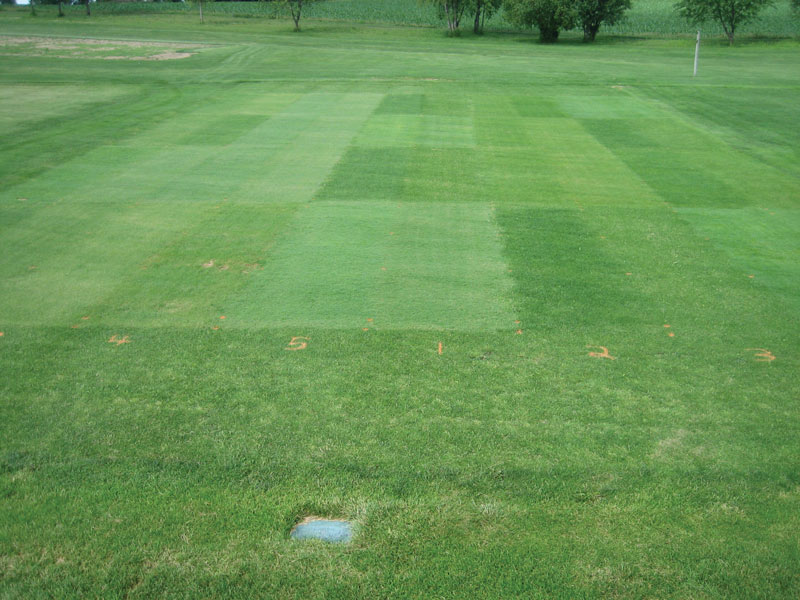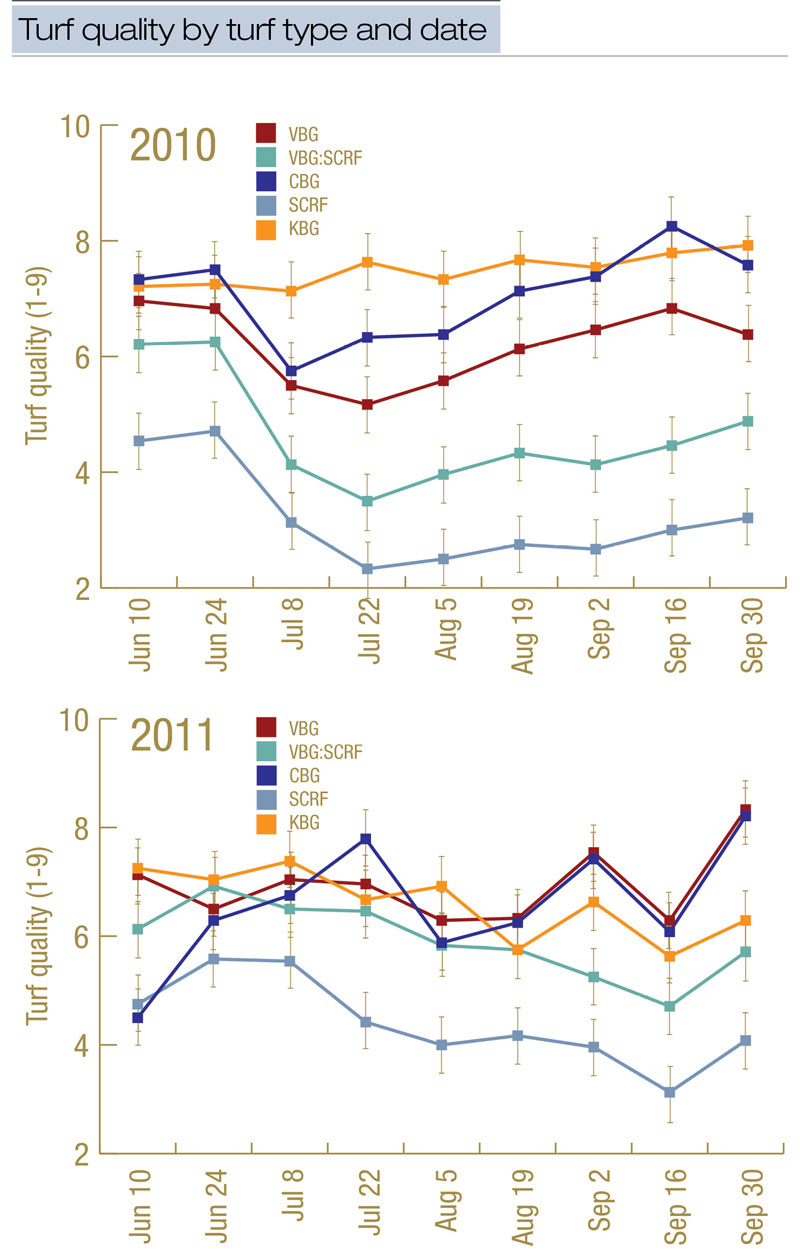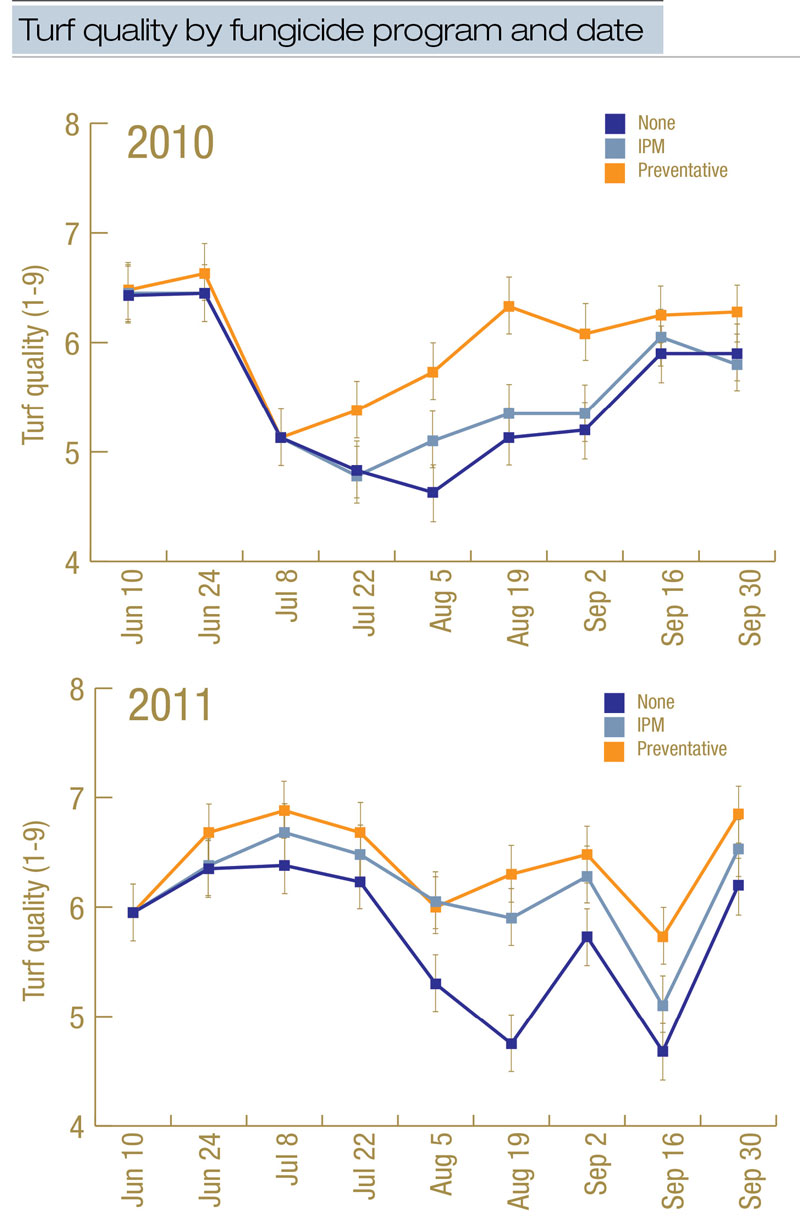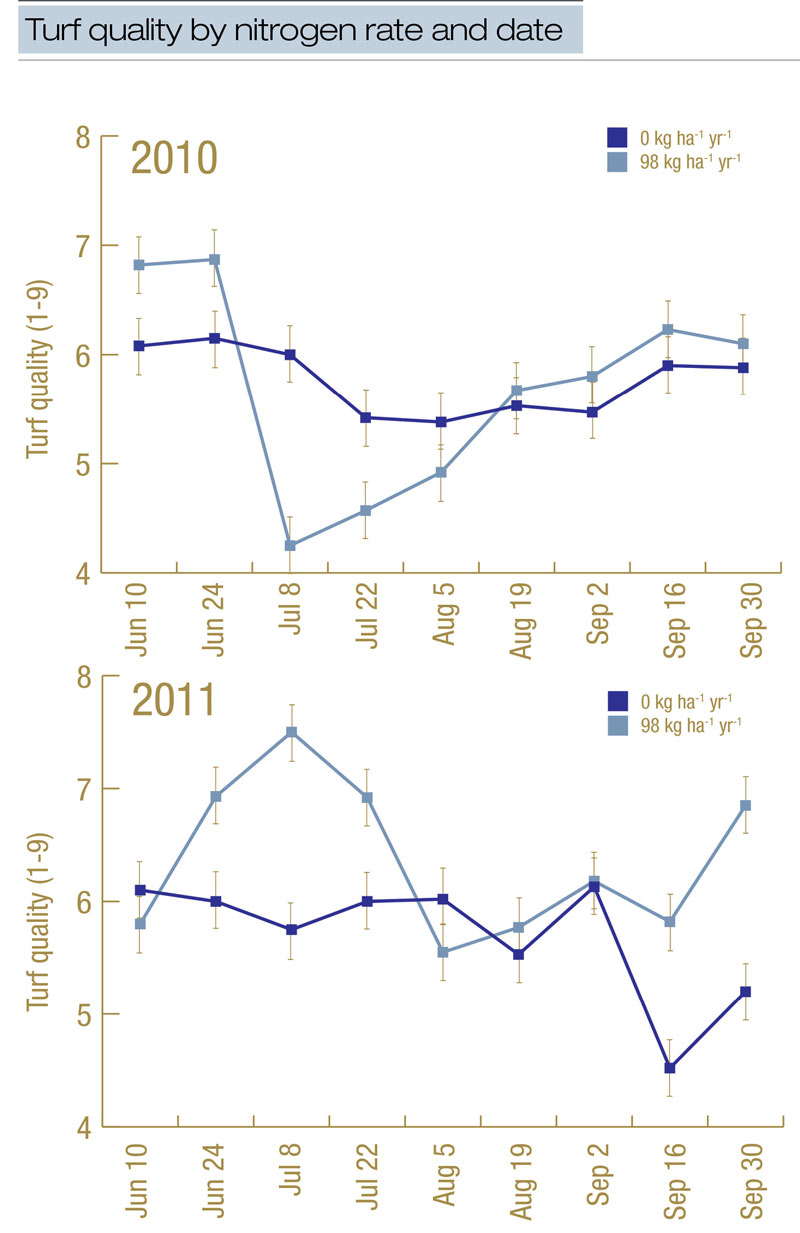
A reduced-input fairway trial plot area at the O.J. Noer Turfgrass Research and Education Facility in Madison, Wis., showing color and stand differences among multiple species/mixes, including Kentucky bluegrass, creeping bentgrass, velvet bentgrass and strong creeping red fescue. Treatments included reduced nitrogen fertility rates and reduced fungicide applications. Photo by Ben Pease
Modern golf course superintendents have the dilemma of maintaining acceptable-quality turf with reduced inputs as golf turf management comes under increasing scrutiny from economic, public and special-interest pressures. Given that fairways account for the majority of finely managed turf areas on golf courses (3), inputs such as fertilizer, pesticides and water may be significantly decreased by adopting minor changes over these large turf areas.
At least 11 U.S. states have restricted phosphorus fertilization since 2004 (7). Additionally, nitrogen applications have been restricted to less than 0.9 pounds per 1,000 square feet (43.9 kilograms per hectare) in Maryland unless an enhanced-efficiency fertilizer is used (8). Cosmetic pesticide use has been banned in Canadian provinces and municipalities (4). Restrictions or bans on irrigation water for turf are occurring in both the western and eastern parts of the U.S. A review concluded that cool-season turfgrasses could be managed without herbicides when inputs such as fertility, irrigation and mowing were optimized (6). Using alternative turfgrasses may accomplish a similar goal of reduced inputs while sustaining turfgrass quality.
Researchers have shown acceptable turf quality can be achieved with alternative species, and sometimes with less inputs. In a low-input cultivar trial, colonial bentgrass (Agrostis capillaris) and fescues (Festuca spp.) performed well in the absence of pesticides, fertilizer or irrigation (12). Minnesota researchers found that velvet bentgrass (A. canina) and colonial bentgrass, and some fescue species, had better quality under trafficked fairway conditions than traditional fairway species (11). Another study (5) found that fescue species had better snow mold resistance than creeping bentgrass (A. stolonifera). These findings indicated acceptable quality, equal to or better than that of the standard fairway turfs of creeping bentgrass or Kentucky bluegrass (Poa pratensis), is possible with alternative turf species.
The main objective of our project was to compare the quality of five fairway turf types as affected by three fungicide programs and two fertility levels. The first hypothesis was that velvet bentgrass would maintain higher quality than creeping bentgrass, and that velvet bentgrass would do so with lower fertility. The second hypothesis was that velvet bentgrass, Kentucky bluegrass and strong creeping red fescue (F. rubra ssp. rubra) would require fewer fungicide applications than creeping bentgrass.
Materials and methods
Fairway plots were established at the O.J. Noer Turfgrass Research and Education Facility near Madison, Wis., on Aug. 17, 2009. A starter fertilizer delivering 1 pound phosphorus pentoxide per 1,000 square feet (49 kilograms per hectare) was broadcast prior to seeding. Experimental units were arranged in a randomized complete block strip-split plot design with four replications. The main plots were Shark creeping bentgrass, Vesper velvet bentgrass, Diva Kentucky bluegrass, Epic strong creeping red fescue, and a 5:95 mixture by weight of Vesper and Epic. The respective seeding rates were 1.1, 1.1, 2.5, 4 and 5 pounds per 1,000 square feet (53.7, 53.7, 122.1, 195.3 and 244.1 kilograms per hectare).
These turfgrass varieties were chosen for this trial because they registered acceptable performance in Midwestern U.S. National Turfgrass Evaluation Program variety trials.
Irrigation was applied as necessary during grow-in. Beginning in the spring of 2010, irrigation was applied three days per week at 60% evapotranspiration (ET) replacement. Mowing began on Sept. 1, 2009, at 0.6-inch (1.5-centimeter) height of cut, was gradually reduced to 0.5 inch (1.3 centimeter), and continued three days per week for the remainder of the trial using a reel mower with the clippings returned. A commercial mixture of Instrata (chlorothalonil, propiconazole and fludioxonil; Syngenta) was applied at 10 fluid ounces per 1,000 square feet (32 liters per hectare) in early November 2009 for preventive snow mold disease (Microdochium nivale and Typhula incarnata) control.
Experimental treatments began in May 2010. The vertical split plots were yearly nitrogen rates of 0 and 2 pounds per 1,000 square feet (0 and 98 kilograms per hectare), split into four equal applications on approximately May 15, July 1, Aug. 15 and Oct. 1 in 2010 and 2011, with granular urea as the nitrogen carrier.
Three fungicide programs were stripped horizontally across each replication: (a) a non-treated fungicide control; (b) a full preventive tank mix of Daconil Weatherstik (chlorothalonil, Syngenta) and Chipco 26GT (iprodione, Bayer) applied at 1 and 0.65 ounces per 1,000 square feet, respectively (3.1 and 2.0 kilograms active ingredient per hectare) every two weeks beginning on May 17, 2010 and 2011; and (c) integrated pest management (IPM): the full preventive fungicide mixture applied when dollar spot (Clarireedia gen. nov.) foci covered 5% or more of an experimental unit or when dollar spot severity was rated above a 5 on a scale of 1 to 9. Instrata was applied at 10 fluid ounces per 1,000 square feet to the full preventive and IPM experimental units on Nov. 19, 2010, to prevent snow mold disease. All fungicides were applied in spray volume equivalent to 2 gallons per 1,000 square feet (815 liters per hectare).
Turfgrass quality was visually rated on nine dates each year on a 1-9 scale, where 1 = bare ground; 5 = minimal acceptable fairway turf; and 9 = optimal density and uniformity. Dollar spot disease severity was rated as necessary on a percentage basis or on a 1-9 scale, where 1 = no disease; 5 = highest acceptable rating; and 9 = completely destroyed by disease. Snow mold disease severity following the 2010-2011 winter was rated on three dates during April and May 2011 on the same 1-9 disease scale noted above.
Turf species effect
In 2010, strong creeping red fescue and velvet bentgrass/strong creeping red fescue had unacceptable quality (3.3 and 4.7 annual means, respectively), while other turf types had quality scores of 6.2 or greater (Figure 1, below). In 2011, only strong creeping red fescue had unacceptable annual mean quality (4.4), whereas velvet bentgrass/strong creeping red fescue recovered to 5.9 by autumn. Kentucky bluegrass and creeping bentgrass both had quality ratings of 6.6; velvet bentgrass had significantly higher quality (6.9) than all other turf types. Strong creeping red fescue and the velvet bentgrass/strong creeping red fescue mixture had unacceptable quality for most of 2010 because both were severely damaged by a Pythium outbreak in mid-July 2010 (important later). Both recovered to acceptable quality in early 2011, but strong creeping red fescue then became unacceptable for the remainder of 2011 because of broadleaf and grassy weed infestation.

Figure 1. Fairway turf quality in 2010 and 2011 as affected by turf type and rating date, averaged across nitrogen rate and fungicide program. Quality was rated on a 1-9 scale, where 1 = completely necrotic turf, 5 = minimally acceptable turf, and 9 = optimal density, uniformity and color. Turf types were velvet bentgrass (VBG); a velvet bentgrass and strong creeping red fescue mixture (VBG-SCRF); creeping bentgrass (CBG); strong creeping red fescue (SCRF); and Kentucky bluegrass (KBG).
Turf type quality varied by rating date in each year. Strong creeping red fescue had the lowest quality on all dates, achieving acceptable quality on only two dates in 2011 (Figure 1). Kentucky bluegrass, velvet bentgrass and creeping bentgrass had acceptable quality on all dates, but velvet bentgrass/strong creeping red fescue had unacceptable quality during most of 2010 because of the Pythium outbreak, recovering to acceptable condition for most of 2011. If not for the Pythium outbreak, strong creeping red fescue or the velvet bentgrass/strong creeping red fescue mixture could be a viable alternative to creeping bentgrass or Kentucky bluegrass. In our trial, velvet bentgrass did not always have higher quality than creeping bentgrass; the two species were usually similar in overall quality, especially during the second year. Cultivar success may depend on specific location conditions, such as soil type and environmental parameters.
Editor’s note: Authors Benjamin Pease and John Stier researched whether velvet bentgrass can be a viable alternative to creeping bentgrass on putting greens under shade stress. Read their findings in Velvet vs. creeping: Managing bentgrasses in shade.
Turf type accounted for nearly 95% of the treatment response variation in snow mold severity. Kentucky bluegrass (1.1) and strong creeping red fescue (1.3) had the least snow mold disease severity. This was not surprising, as snow mold is of minor concern in Kentucky bluegrass (9), and fescues are more tolerant of snow mold pathogens than bentgrasses (5). The velvet bentgrass/strong creeping red fescue mixture (1.4) had a similar score to strong creeping red fescue. Vesper velvet bentgrass had greater but still acceptable snow mold disease severity (2.1), while Shark creeping bentgrass had the greatest snow mold disease severity (5.0). The National Turfgrass Evaluation Program trials have shown that creeping bentgrass snow mold tolerance is cultivar-dependent, but snow mold resistance of velvet bentgrass cultivars is not extensively known. Vergara and Bughrara (2009) examined the snow mold resistance of 41 Agrostis cultivars; only two were velvet bentgrass, and these were in the group with the greatest disease resistance.
Fungicide program effect
Rating date affected fungicide program performance on most dates in both years (Figure 2, below). On all dates of significance, the full preventive program had higher quality than at least the no-fungicide program. The no-fungicide program had unacceptable quality on four of 18 rating dates over the two-year trial. In the absence of preventive Pythium control, especially regarding fertilized experimental units, strong creeping red fescue, the velvet bentgrass/strong creeping red fescue mixture and velvet bentgrass may not be considered low-input species. These species would occasionally need preventive fungicide applications, as Pythium is likely at least one time per year, depending on the weather and location (2). Kentucky bluegrass was the only turf type that was not affected by Pythium blight.

Figure 2. Fairway turf quality in 2010 and 2011 as affected by fungicide program and rating date, averaged across nitrogen rate and turf type. Quality was rated on a 1-9 scale, where 1 = completely necrotic turf, 5 = minimally acceptable turf, and 9 = optimal density, uniformity and color. Fungicide treatments were (1) no fungicides, (2) fungicides applied at 5% disease threshold (integrated pest management, IPM), and (3) preventive control program.
The IPM fungicide program required only one application in each year. In August 2010, non-fertilized creeping bentgrass and velvet bentgrass/strong creeping red fescue experimental units and fertilized strong creeping red fescue and velvet bentgrass/strong creeping red fescue experimental units required curative dollar spot control. In June 2011, non-fertilized creeping bentgrass and velvet bentgrass experimental units required curative dollar spot control. Because of the low dollar spot disease pressure in both years of our trial, we were not able to determine comprehensive dollar spot fungicide need trends, although non-fertilized plots were more likely to need a fungicide application than fertilized plots.
Our nitrogen rate of 2 pounds per 1,000 square feet may have contributed to the low disease pressure and would be considered a high nitrogen rate compared with the nitrogen rate investigated by Watkins et al. (2001), who found that 0.6 pounds nitrogen per 1,000 square feet (29.3 kilograms per hectare) was sufficient to increase fungicide treatment intervals for the control of dollar spot on creeping bentgrass fairways. With the exception of our fertilized treatments involving strong creeping red fescue, fertilized treatments never required an IPM curative fungicide application.
Nitrogen rate effect
Rating date also affected turfgrass quality, averaged across all turf types, by nitrogen rate on most dates in both years (Figure 3, below). The drop in the quality of the fertilized plots in July 2010 was caused by the Pythium blight outbreak. The quality of fertilized plots in the first half of 2011 was higher than that of the non-fertilized plots because the fertilized plots quickly recovered from snow mold damage. Non-fertilized plots were never below a quality rating of 5 until weed infestation in late 2011. Fertilized Kentucky bluegrass always had acceptable quality, but non-fertilized Kentucky bluegrass would have benefited from one herbicide application in the second year to sustain acceptable quality. Optimized, or at least minimal, fertilization is necessary to benefit the desired turfgrass species over weed encroachment (6).

Figure 3. Fairway turf quality in 2010 and 2011 as affected by nitrogen rate and rating date, averaged across fungicide program and turf type. Quality was rated on a 1-9 scale, where 1 = completely necrotic turf, 5 = minimally acceptable turf, and 9 = optimal density, uniformity and color.
Conclusion
Our results show that velvet bentgrass or a velvet bentgrass/strong creeping red fescue mixture has a similar chance at success compared with creeping bentgrass in a low-input setting in the northern Midwest United States. The low fertility requirements of velvet bentgrass (the non-fertilized velvet bentgrass experimental units were nearly equal in quality to the fertilized experimental units) and its resistance to snow mold relative to creeping bentgrass provides a turf requiring relatively less fertility and fungicides. A second option for the northern Midwest United States could be a velvet bentgrass/fine-leaf fescue mixture, depending on the fescue variety.
For fairway turf to be of acceptable quality, base levels of fertility are necessary, along with weather-dependent disease management through fungicide applications. Velvet bentgrass and the velvet bentgrass/strong creeping red fescue mixture could provide a low-input alternative to creeping bentgrass fairways. This trial’s contribution toward the future adoption of alternative turf cultures could be the differences in snow mold tolerance measured among the turf types. If snow mold fungicides are ever restricted in the United States, as they are in Scandinavia (1), and golfers still demand bentgrass, velvet bentgrass may be a viable option. Further investigation into intraspecific differences is necessary before fully recommending velvet bentgrass as a low-input fairway turf.
Acknowledgements
Appreciation is extended to Tom Schwab, the former University of Wisconsin turfgrass research station superintendent. The authors also thank student workers David Anderson, Sean O’Brien and Matt Karls for help with data collection and plot maintenance.
The research says ...
- Base levels of fertility are necessary for alternative fairway turfgrasses to be successful.
- Velvet bentgrass with and without a fescue species has potential as a fairway turfgrass.
- Velvet bentgrass has a similar chance of success as creeping bentgrass in a low-input setting in the northern Midwest U.S.
Literature cited
- Aamlid, T.S., W.M. Waalen and T. Espevig. 2014. Fungicide strategies for the control of turfgrass winter diseases. Acta Agriculturae Scandinavica 65(2):161-169 (https://doi.org/10.1080/09064710.2014.985249).
- Clarke, B.B., P. Vincelli, P. Koch and G. Munshaw. 2019. Chemical control of turfgrass diseases 2020. Kentucky Cooperative Extension (https://www2.ca.uky.edu/agcomm/pubs/PPA/PPA1/PPA1.pdf).
- Gelernter, W.D., L.J. Stowell, M.E. Johnson and C.D. Brown. 2017. Documenting trends in land-use characteristics and environmental stewardship programs on U.S. golf courses. Applied Turfgrass Science 3(1):1-12 (https://doi.org/10.2134/cftm2016.10.0066).
- Government of Quebec. 2011. The pesticides management code. Oct. 27, 2011 (https://www.environnement.gouv.qc.ca/index_en.asp).
- Gregos, J., M.D. Casler and J.C. Stier. 2011. Resistance of closely mown fine fescue and bentgrass species to snow mold pathogens. Plant Disease 95(7):847-852 (https://doi.org/10.1094/PDIS-11-10-0791).
- Hahn, D., R. Sallenave, C. Pornaro and B. Leinauer. 2020. Managing cool-season turfgrass without herbicides: Optimizing maintenance practices to control weeds. Crop Science 60(5):2204-2220 (https://doi.org/10.1002/csc2.20175).
- Lee, S., and L. McCann. 2018. Passage of phosphorus-free lawn fertilizer laws by U.S. states. Journal of Natural Resources Policy Research 8(1-2):66-88 (https://scholarlypublishingcollective.org/psup/jnrpr/article/8/1-2/66/200393/Passage-of-Phosphorus-free-Lawn-Fertilizer-Laws-by).
- State of Maryland. 2014. Fertilizer application requirements for land not used for agricultural purposes. Annotated Code of Maryland. May 25, 2021 (https://mda.maryland.gov/resource_conservation/Documents/Fertilizer_Law.pdf).
- Turgeon, A.J. 2005. Turfgrass management. Eighth edition. Pearson/Prentice Hall, Upper Saddle River, N.J.
- Vergara, G.V., and S.S. Bughrara. 2009. Potential resistance to gray snow mold in colonial bentgrass germplasm and divergent natural creeping bentgrass clones. International Turfgrass Society Research Journal 11(1):583-597.
- Watkins, E., A.B. Hollman and B.P. Horgan. 2010. Evaluation of alternative turfgrass species for low-input golf course fairways. HortScience 45(1):113-118 (https://doi.org/10.21273/HORTSCI.45.1.113).
- Watkins, E., D.S. Gardner, J.C. Stier, D.J. Soldat, R.A. St. John, N.E. Christians et al. 2014. Cultivar performance of low-input turfgrass species for the north central United States. Applied Turfgrass Science 11(1):1-7 (https://doi.org/10.2134/ats-2013-0101-rs).
- Watkins, J.E., R.C. Shearman, R.E. Gaussoin, W.K. Cecil, M. Vaitkus and L.A. Wit. 2001. An integrated approach to dollar spot management on a bentgrass fairway. International Turfgrass Society Research Journal 9:729-735.
Benjamin W. Pease is a turfgrass agronomist at The Andersons Inc., Maumee, Ohio. John C. Stier is a professor and associate dean in the College of Agricultural Sciences and Natural Resources at the University of Tennessee, Knoxville.